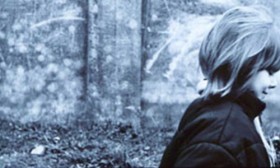


Gus Holwerda: The Unbelievers/ 2
Herzog taler sig bestemt ikke igennem filmen (havde han dog bare gjort det…), der er ikke så meget mere end på traileren. Hans rolle er at anbefale filmen, og det gør han ved at anbefale de to unbelievers, biologen Richard Dawkins fra Oxford og fysikeren Lawrence Krauss fra Phoenix. Vi har alle brug for modige mennesker som disse, som taler om nødvendigheden af videnskab og fornuft som grundlag for at forstå vores omverden, siger han.
Herzog speaker altså ikke filmen roligt, indtrængende og skarpt, som han ville kunne, som jeg opfattede traileren lovede, som var min egentlige begrundelse for at åbne for Dokumania i aftes. Han kommer altså slet ikke til orde i filmen, som tværtimod støjende, overfladisk og sjusket prøver at dække Dawkins og Krauss på en verdensturné med foredrag og interviews. Jeg synes, det er uudholdeligt, men de er sympatiske og fascinernede hovedpersoner, og det holder mig fast, for der er dog et par scener, som den på fotoet her, hvor de to vist nok, har jeg på fornemmelsen, vist nok i virkeligheden karismatiske videnskabsmænd begynder at udfolde sig i en ordentlig samtale. Jeg, der ellers er smidt af fortællingen, finder i disse få gode scener ind til, hvad der kunne have været en dokumentarfilm, et værk, som kunne bevæge og flytte mig.
Hvad er der da i vejen? Jeg oplever filmen indforstået, og det plejer bestemt ikke at gøre mig noget, hvis værket ikke tager hensyn til mig af den grund, men her er der en åbenlys arrogance, som forudsætter, at jeg kender de to fra amerikanske shows, så de uden videre kan fortsætte i stilen med fikse hentydninger uden at gå i dybden med noget som helst, men bare klippe til den sjoveste replik, som netop kun er indforstået morsom. Der er imidlertid fem til syv gode scener, hvor et argument føres igennem, hvor en udredning gives plads. Og så er der de tos samvær, hvor en stemning af dokumentarisk ægthed viser sig, om ikke realiseret, så en anet mulighed, et kig bagom den smagløst hæsblæsende konstruktion af overfladiskheder.
Kan dette være rigtigt? Jeg ser filmen en gang til og undrer mig. Der er ikke mere, den kommer ikke længere, ikke dybere. Og jeg konkluderer med at tildele den to penne af seks (den ene pen ekstra alene for for de længere scener med de to medvirkende alene i et foredrag, alene sammen i denne samtale, som er så vigtig og så forsømt), og jeg finder nogle anmeldelser frem (i tvivl, er det kun mig, som ser den film sådan?) og ser, at den ikke blev særlig godt modtaget i USA, og jeg vil gøre The New York Times’ Jeannette Catsoulis’ beskrivelse i hendes anmeldelse (12. december 2013) til min. Netop sådan tænkte jeg faktisk, da jeg så filmen:
”Accompanying the respected scientists and atheists Richard Dawkins and Lawrence Krauss on a triple-continent series of public engagements, Gus Holwerda’s unforgivably superficial documentary is too busy drooling over its subjects to flesh out their body of work. Whether debating Muslims in Canberra, Australia, or making rhetorical mincemeat of the archbishop of Sydney; bantering with Stephen Colbert in New York City; or holding forth at the 2012 Reason Rally in Washington, this genial tag team is photographed with the deference of star-struck teenagers. Train, cab and airplane journeys between locations are pointlessly recorded, as is Mr. Krauss’s spell in a makeup chair and the vibrant hue of his pink sneakers — as though to underscore their wearer’s nonconformity…” Og Jeannette Catsoulis konkluderer: ”Too slight to Persuade, ’The Unbelievers’ is also too poorly made to entertain. The rational roots of atheism deserve a much better movie that this.”
USA, 2013, 75 min.
